What to do and where to go in Yangon
2018-08-25edit Florence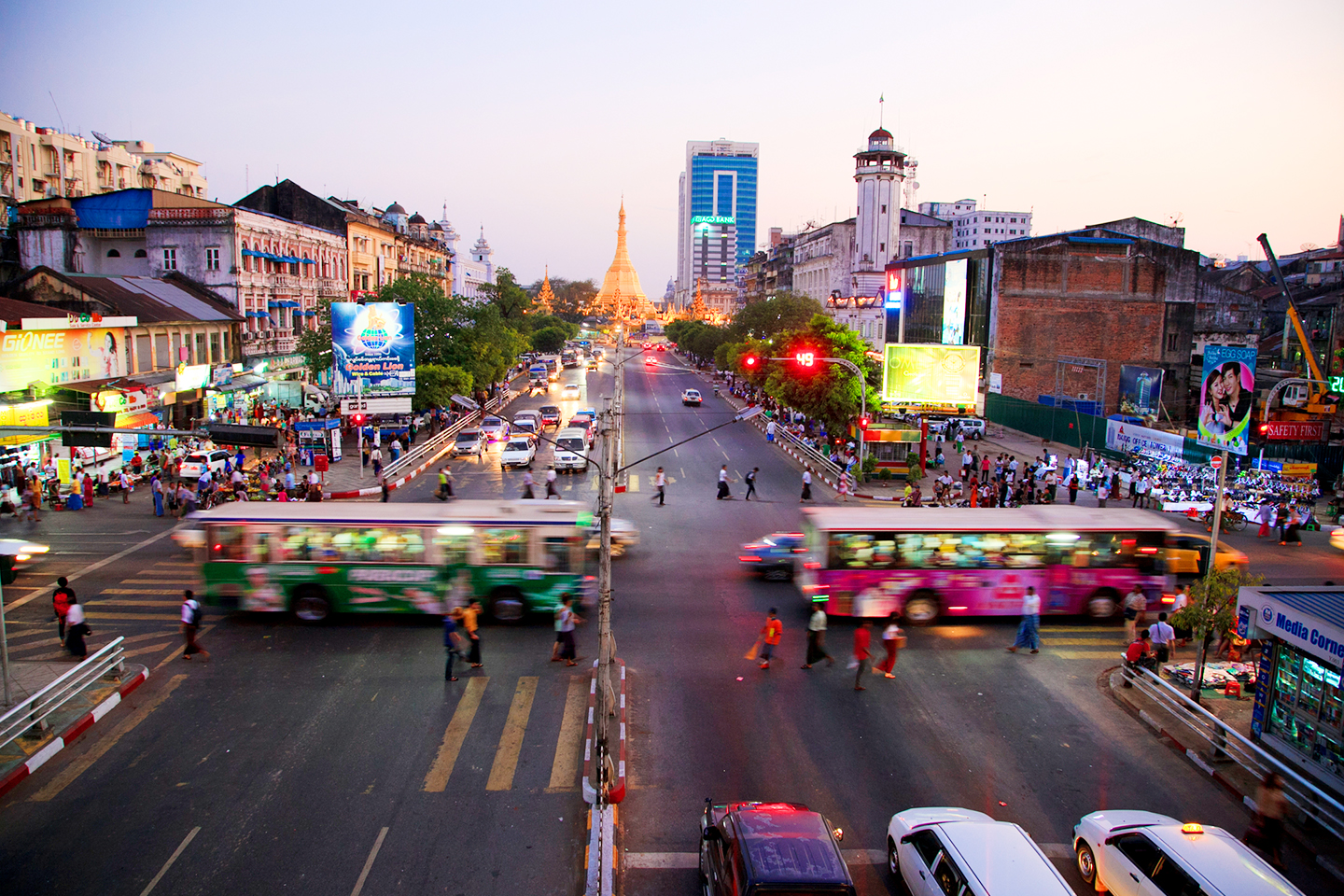 Yangon (also known as Rangoon) is the largest city of the Republic of the Union of Myanmar (formerly known as Burma) which was founded as Dagon in the early 11th century and later renamed it to “Yangon”. During the first Anglo Burmese War, Yangon was taken by the British. It was known as “the Garden city of the East” among South East Asia countries. Colonial buildings, mix of modern buildings, parks, lakes, traditional wood architecture and pagodas show the prestige of the city. As Yangon was the former British colonial capital, you can see many colonial buildings in the downtown area.
Yangon (also known as Rangoon) is the largest city of the Republic of the Union of Myanmar (formerly known as Burma) which was founded as Dagon in the early 11th century and later renamed it to “Yangon”. During the first Anglo Burmese War, Yangon was taken by the British. It was known as “the Garden city of the East” among South East Asia countries. Colonial buildings, mix of modern buildings, parks, lakes, traditional wood architecture and pagodas show the prestige of the city. As Yangon was the former British colonial capital, you can see many colonial buildings in the downtown area.
Start your day from former British colonial capital
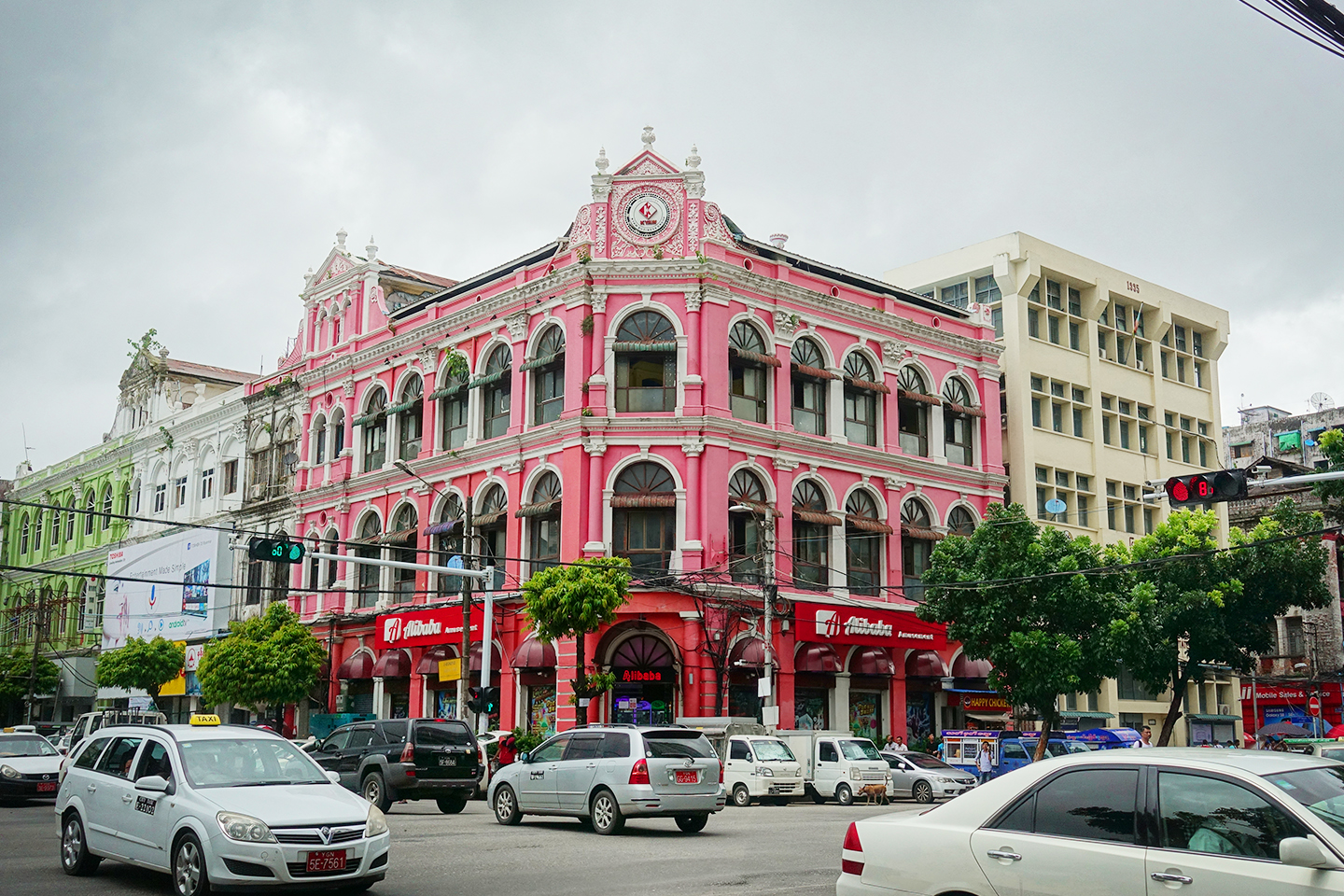

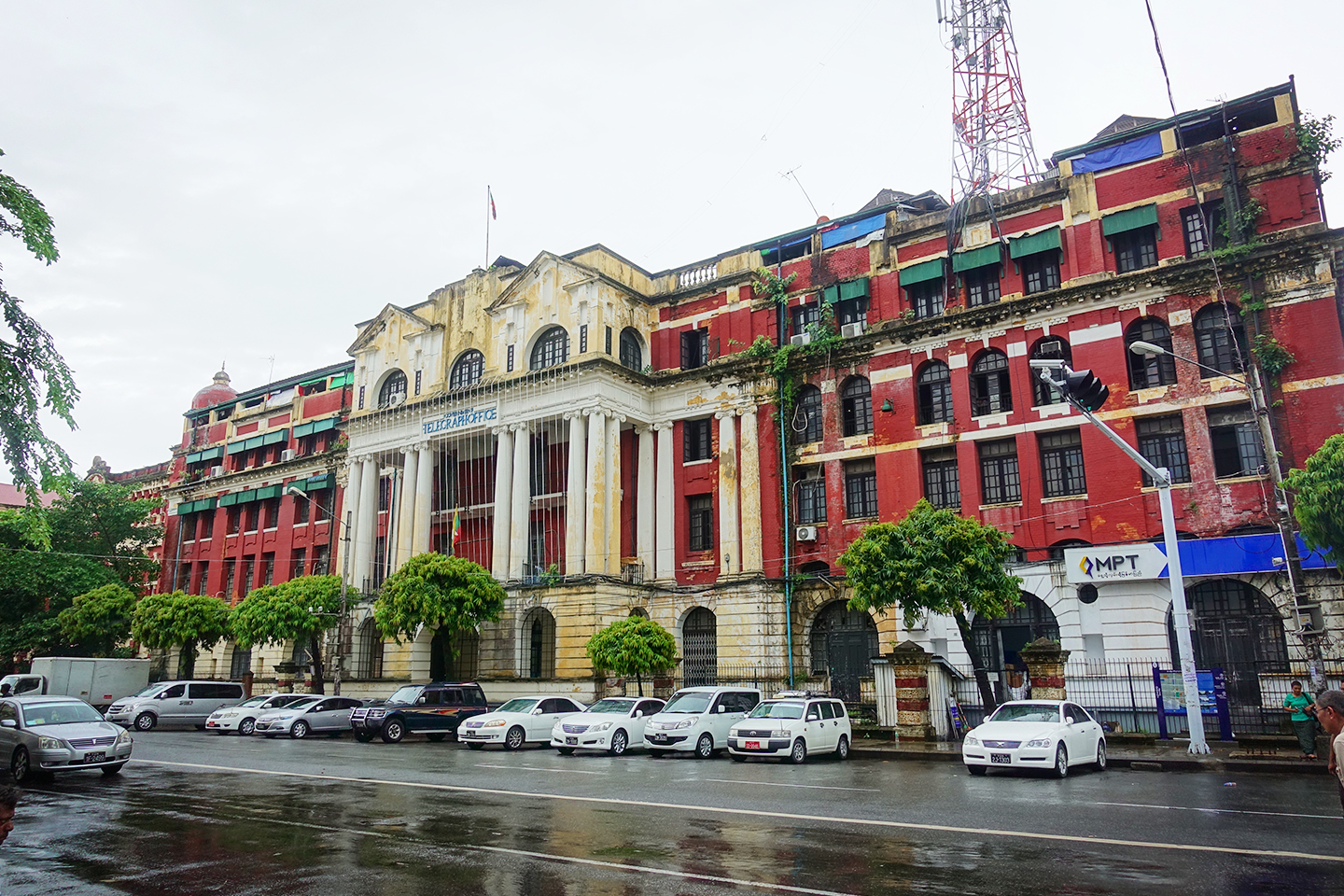 Normally a couple day is enough to visit Yangon. But if you only have a single day to spend, it is still possible. Before the exploration, start your day with the morning coffee at The Strand Hotel which was built in 1901 and it was one of the famous colonial buildings in Asia. The Strand Café is not only famous for its peaceful & classic atmosphere but also for its delicious breakfast as well as Strand High Tea. This might be a good start of Yangon because of its luxurious decoration and architecture. There are lots of places you can see and spend your time wandering around the central Yangon. The Yangon City Hall, the former High Court, the former Secretariat Buildings, Saint Mary 's Cathedral, the Saint Paul’s English High School (now known as No. 6 Basic Education High School, Botataung) and the Strand Hotel are the excellent examples of city heritage structure.
Normally a couple day is enough to visit Yangon. But if you only have a single day to spend, it is still possible. Before the exploration, start your day with the morning coffee at The Strand Hotel which was built in 1901 and it was one of the famous colonial buildings in Asia. The Strand Café is not only famous for its peaceful & classic atmosphere but also for its delicious breakfast as well as Strand High Tea. This might be a good start of Yangon because of its luxurious decoration and architecture. There are lots of places you can see and spend your time wandering around the central Yangon. The Yangon City Hall, the former High Court, the former Secretariat Buildings, Saint Mary 's Cathedral, the Saint Paul’s English High School (now known as No. 6 Basic Education High School, Botataung) and the Strand Hotel are the excellent examples of city heritage structure.
Sule Pagoda, one of the oldest pagodas in Myanmar
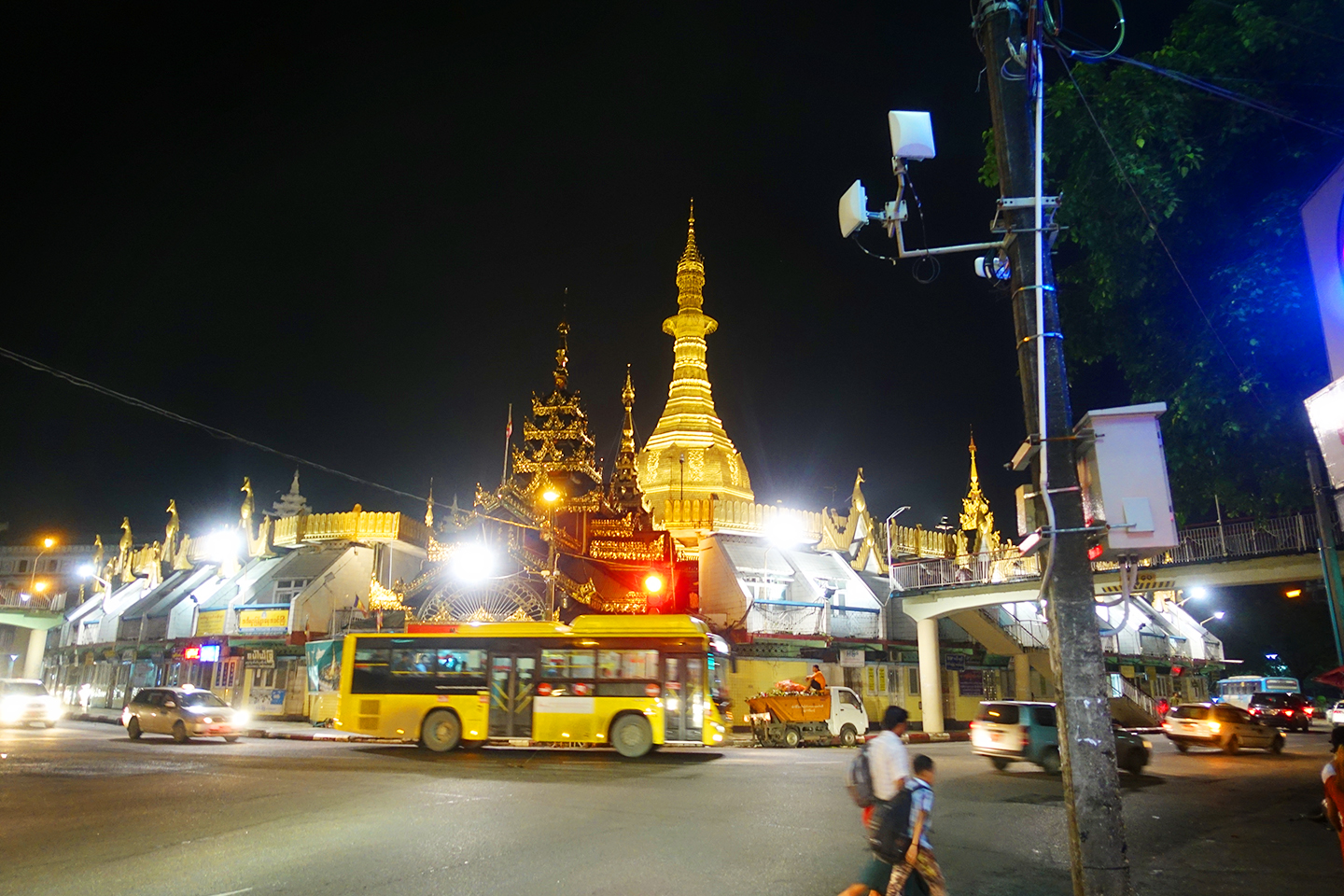 The Primary religions in Yangon are Buddhism, Christianity, Hinduism and Islam. Yangon has many temples and pagodas. The country’s oldest and most famous pagodas are Botahtaung, Sulé and Shwedagon pagodas. The people believed that those pagodas was built at the time of the Buddha was alive and later renovated over the centuries. Not very far from the Strand Hotel, there is the Sule Pagoda which situated not only in the heart of Yangon but also at the political and religious focal point. You can take Taxi to the pagoda which will cost around 1 or 2 USD. This pagoda is listed on the “Yangon City Heritage List” and it is believed to enshrine a strand of hair relic of the Buddha. It was constructed in early 2600 years ago during the time of the Buddha was alive. According to the history of the pagoda, it was named after the Sule Nat (spirit) that lived at the spot where the pagoda now stands. Various explanations have been made for the name in the history of the pagoda. In 1988 and 2007, the pagoda was the gathering point for the pro-democracy protestors. It opens daily from 4:00 to 22:00 and the entrance fees cost 3,000 Kyats per person.
The Primary religions in Yangon are Buddhism, Christianity, Hinduism and Islam. Yangon has many temples and pagodas. The country’s oldest and most famous pagodas are Botahtaung, Sulé and Shwedagon pagodas. The people believed that those pagodas was built at the time of the Buddha was alive and later renovated over the centuries. Not very far from the Strand Hotel, there is the Sule Pagoda which situated not only in the heart of Yangon but also at the political and religious focal point. You can take Taxi to the pagoda which will cost around 1 or 2 USD. This pagoda is listed on the “Yangon City Heritage List” and it is believed to enshrine a strand of hair relic of the Buddha. It was constructed in early 2600 years ago during the time of the Buddha was alive. According to the history of the pagoda, it was named after the Sule Nat (spirit) that lived at the spot where the pagoda now stands. Various explanations have been made for the name in the history of the pagoda. In 1988 and 2007, the pagoda was the gathering point for the pro-democracy protestors. It opens daily from 4:00 to 22:00 and the entrance fees cost 3,000 Kyats per person.
The Independence Monument at the Maha Bandula Park
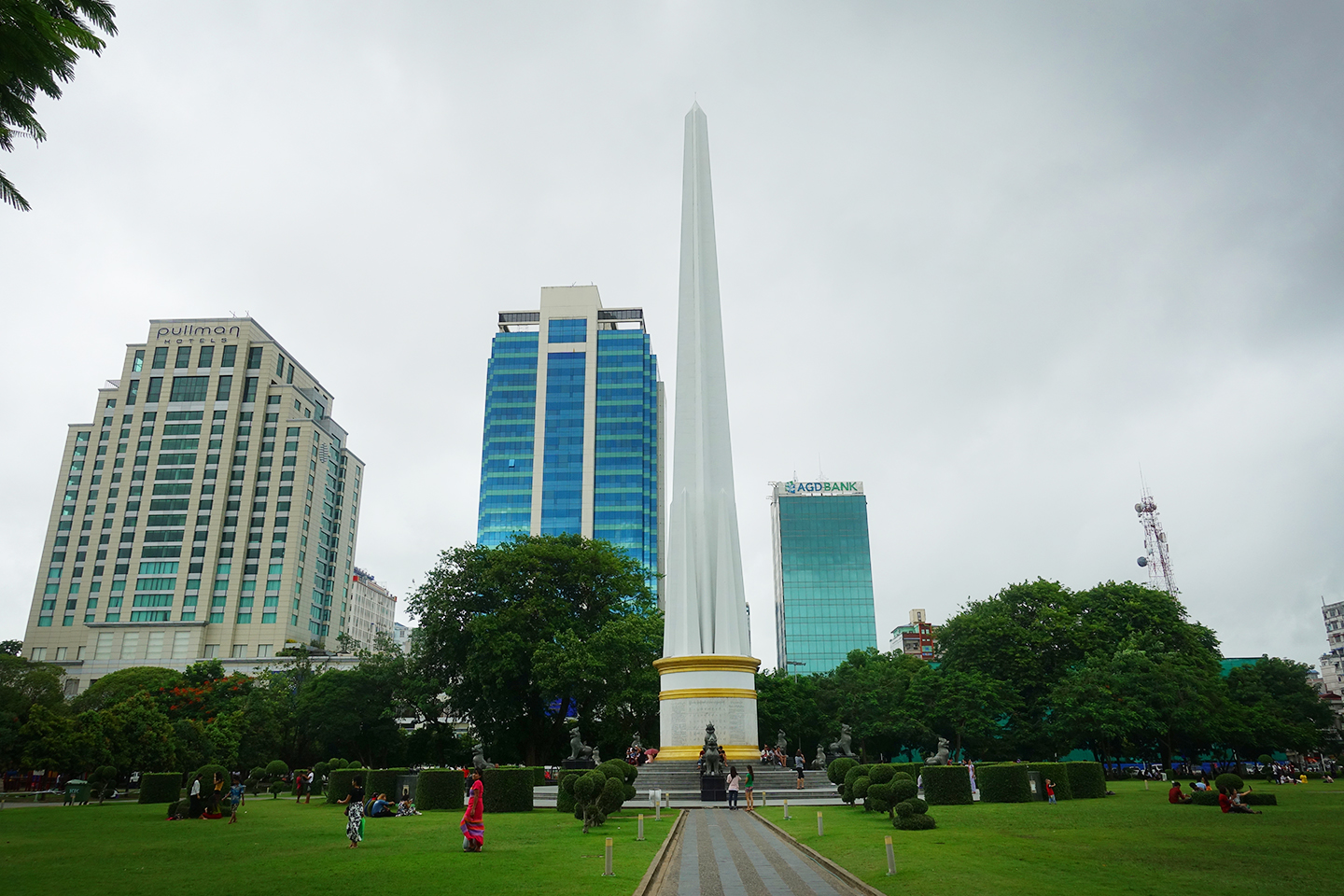
 Maha Bandula Park is just next to the Sule pagoda, the Yangon City Hall and the High court building. The park was named after General Maha Bandula who fought back the British in the First Anglo Burmese War. In 1948, the Independence Monument was built at the center of the park as a commemoration of the Myanmar independence from the British and now becomes the recreational park for the people. The park opens daily from 5:00 to 18:30.
Maha Bandula Park is just next to the Sule pagoda, the Yangon City Hall and the High court building. The park was named after General Maha Bandula who fought back the British in the First Anglo Burmese War. In 1948, the Independence Monument was built at the center of the park as a commemoration of the Myanmar independence from the British and now becomes the recreational park for the people. The park opens daily from 5:00 to 18:30.
Bogyoke Aung San Market or Scott Market
Bogyoke Aung San Market was built in 1926 (named after Mr. Gavin Scott, the Municipal Commissioner). Later in 1948 after Burmese Independence, it was renamed to Bogyoke (General) Aung San Market. The Market is known for its colonial architecture and it is one of the major tourist destinations. It is not only famous for foreigners but also to locals because of its wholesale & retail shops. The market has many shops such as jewelry, silverware, brassware, art galleries, antique, handicrafts, lacquer ware, wood and ivory carvings, souvenir, money changers, garment, clothing, shoes, food and many more. Jades, rubies and other precious stones are sold on the ground floor and at the main hall of the market. Numerous Burmese handicrafts, antique and souvenir shops also attract foreigners. The market opens daily from 10:30 to 17:00 except Monday and public holiday.
Taking a break with unique lunch
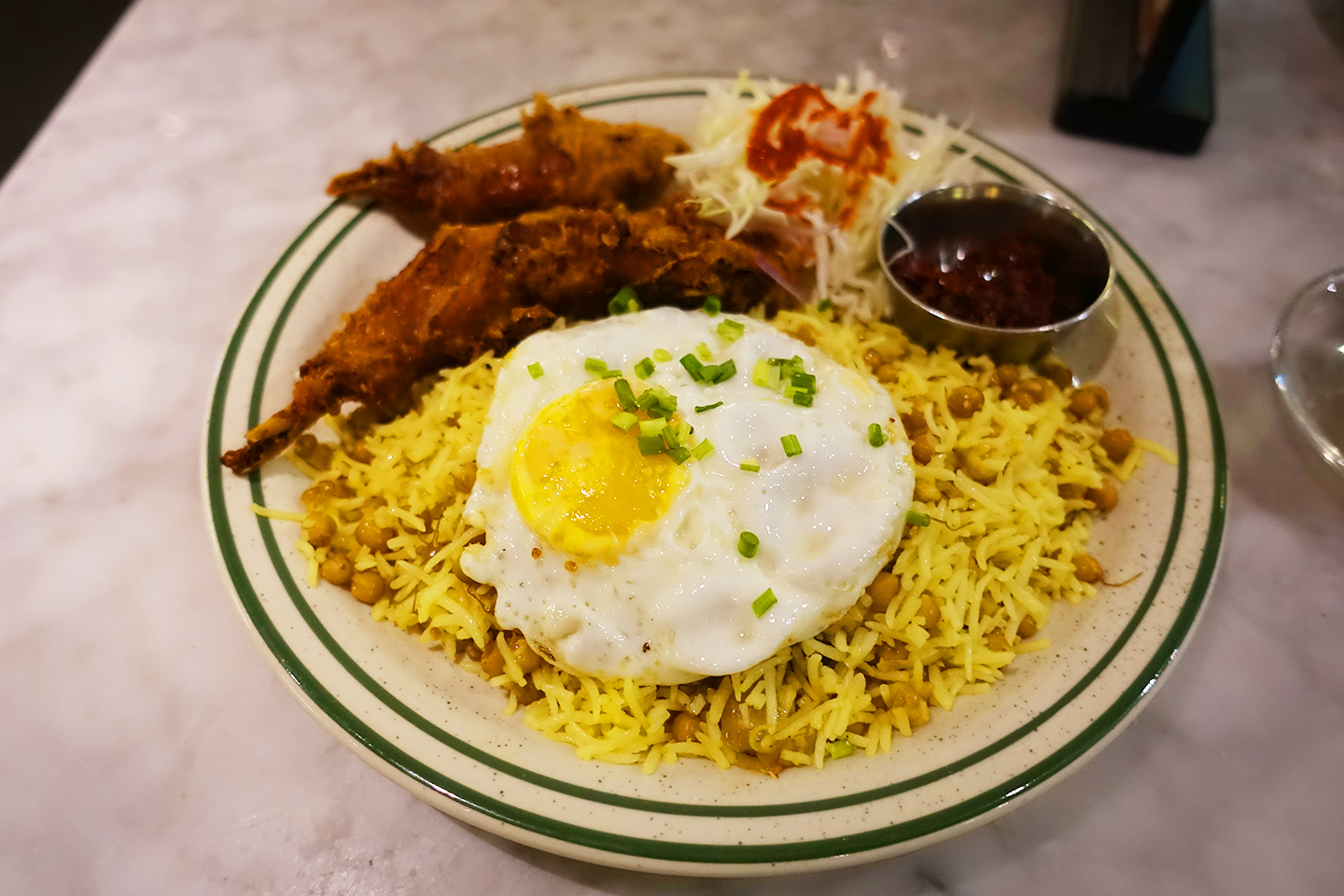 After your half day spend in Yangon, have lunch at Junction City which is just at the opposite site of the Bogyoke Aung San Market. There are many choices like fast foods, cafe and bakery, Thai, Japanese, Chinese, Vietnamese, European restaurants and also have food court which sells variety of foods. It is very convenience and hygienic. Moreover, you should try “Rangoon Tea House” if you are interested in Myanmar cuisine. It is rated 4.5 out of 5 on TripAdvisor and which is situated on the Pansodan Road (Lower Middle Block). You can try a hot bowl of Mohinga (rice noodle with fish soup) or different varieties of high quality tea collections.
After your half day spend in Yangon, have lunch at Junction City which is just at the opposite site of the Bogyoke Aung San Market. There are many choices like fast foods, cafe and bakery, Thai, Japanese, Chinese, Vietnamese, European restaurants and also have food court which sells variety of foods. It is very convenience and hygienic. Moreover, you should try “Rangoon Tea House” if you are interested in Myanmar cuisine. It is rated 4.5 out of 5 on TripAdvisor and which is situated on the Pansodan Road (Lower Middle Block). You can try a hot bowl of Mohinga (rice noodle with fish soup) or different varieties of high quality tea collections.
[More Information] https://mingalago.com/en/interest/detail/rangoon-tea-house
Botataung Pagoda
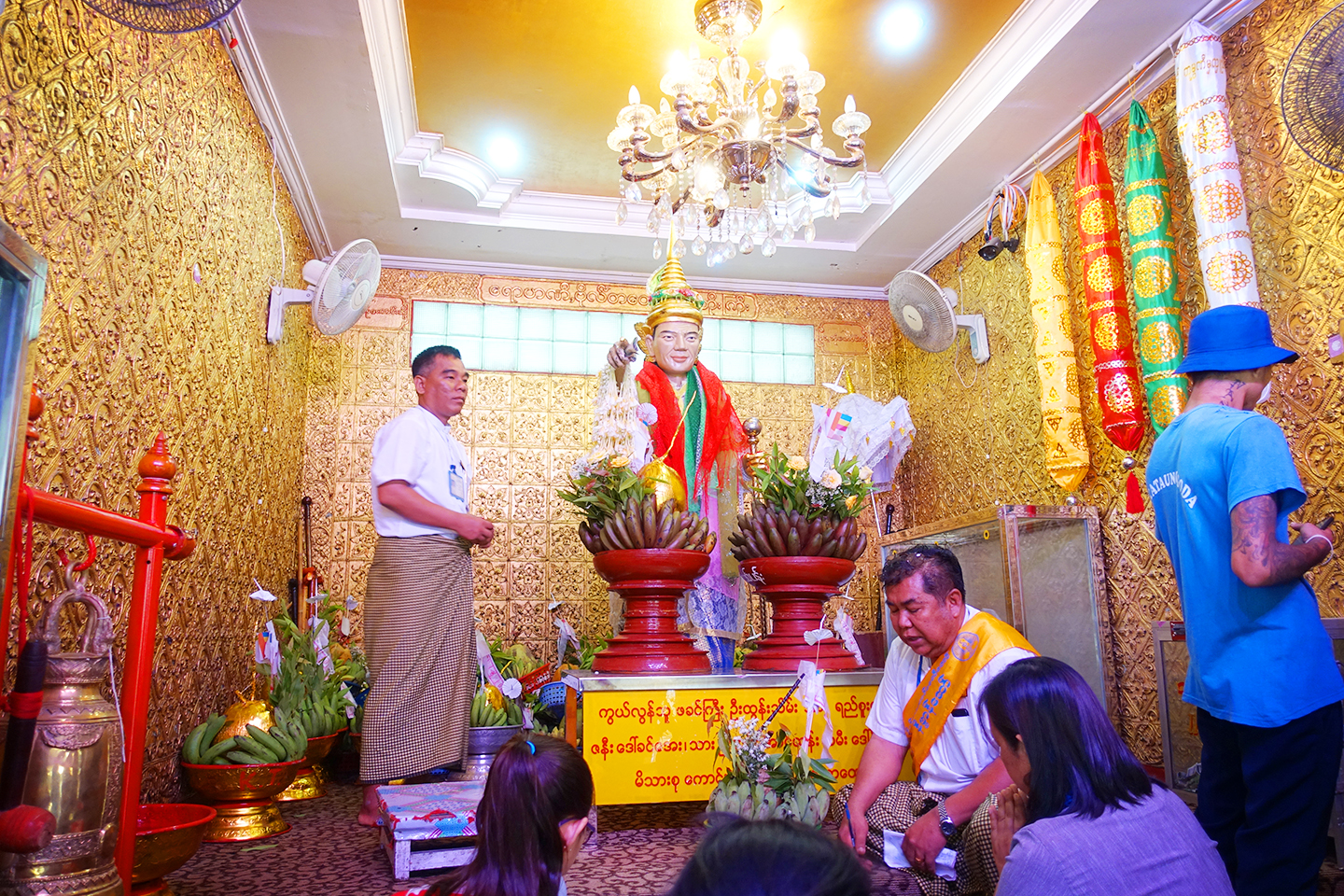 Another famous pagoda in Yangon is called Botatung Pagoda which located near Yangon River and it was built over 2500 years ago. It is famous because of the stupa's hollow inside and mirrored maze-like pathway lined with glass cabinets showing many ancient relics, artifacts and treasures such as precious stones, ornaments, jewelry, terracotta plaques, coins, etc. Unlike other stupas, it is opened to the public and anyone can venerate the hair relic of Buddha and other relics. It opens daily from 6:00 to 20:00 and the entrance fees cost 6,000 Kyats per person.
Another famous pagoda in Yangon is called Botatung Pagoda which located near Yangon River and it was built over 2500 years ago. It is famous because of the stupa's hollow inside and mirrored maze-like pathway lined with glass cabinets showing many ancient relics, artifacts and treasures such as precious stones, ornaments, jewelry, terracotta plaques, coins, etc. Unlike other stupas, it is opened to the public and anyone can venerate the hair relic of Buddha and other relics. It opens daily from 6:00 to 20:00 and the entrance fees cost 6,000 Kyats per person.
Chaukhtatgyi Pagoda or the Reclining Buddha
 Chaukhtatgyi Pagoda is well known for its 65 meters long and 16 meters high Reclining Buddha image. You can also see the soles of Buddha feet contain 108 segments that shows the detail images representing the 108 auspicious signs of the Buddha. It opens daily from 6:00 to 20:00 with no entrance fees.
Chaukhtatgyi Pagoda is well known for its 65 meters long and 16 meters high Reclining Buddha image. You can also see the soles of Buddha feet contain 108 segments that shows the detail images representing the 108 auspicious signs of the Buddha. It opens daily from 6:00 to 20:00 with no entrance fees.
Shwedagon Pagoda, the landmark of Myanmar
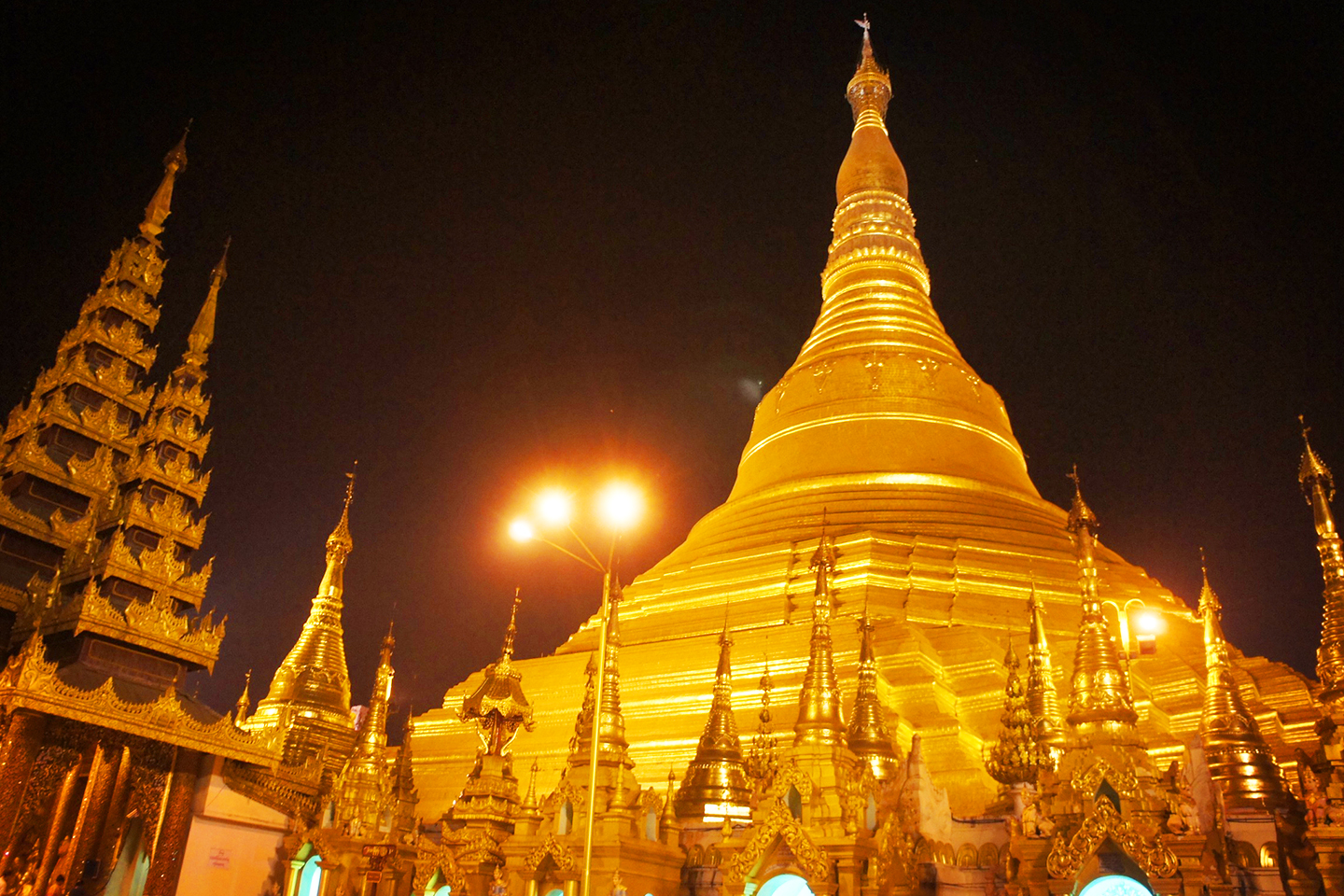 Shwedagon Pagoda is a must visit sightseeing place because it is not only the famous landmark of Myanmar but also the heart of the Buddhism in Myanmar. It is over 2,600 years old and one of the oldest Buddhist stupas in the world with rich histories. There are four entrances with a pair of giant leogryphs (lion like creatures) guarding each entrance. The pagoda is enshrined with Buddha hair relics and covered with genuine gold plates and many precious stones such as diamonds, rubies, sapphires, etc. There is a 76 carats diamond at the diamond bud which is the very top part of the pagoda. It opens daily from 6:30 to 22:00 and the entrance fees costs 10,000 Kyats per person.
Shwedagon Pagoda is a must visit sightseeing place because it is not only the famous landmark of Myanmar but also the heart of the Buddhism in Myanmar. It is over 2,600 years old and one of the oldest Buddhist stupas in the world with rich histories. There are four entrances with a pair of giant leogryphs (lion like creatures) guarding each entrance. The pagoda is enshrined with Buddha hair relics and covered with genuine gold plates and many precious stones such as diamonds, rubies, sapphires, etc. There is a 76 carats diamond at the diamond bud which is the very top part of the pagoda. It opens daily from 6:30 to 22:00 and the entrance fees costs 10,000 Kyats per person.
[More Information] https://mingalago.com/en/interest/detail/shwedagon-pagoda
Wandering around Yangon

 The downtown area is always crowded with both locals and foreigners. If you have a little more time, enjoy the Yangon Night life. There are many bars, beer stations, clubs and restaurants in Yangon. Sharky’s restaurant at lower Pansodan road, Yangon Yangon rooftop bar in Sakura Tower (near Sule Shangri-la Hotel), 50th street restaurants & bars are some popular bars in downtown Yangon. In addition, Sport bar at Mya Yeik Nyo Hotel, the bar Bur Dubai, Jasmin Palace Pool bar, Atlas Rooftop Bar & Lounge are some popular bars in Yangon. The 19th Street is popular street with many beer stations which located in the Chinatown area and Kosan bar is one of the most popular bars. If you are interested in the street foods, there are many food stalls around that area and the night market is also nearby.
The downtown area is always crowded with both locals and foreigners. If you have a little more time, enjoy the Yangon Night life. There are many bars, beer stations, clubs and restaurants in Yangon. Sharky’s restaurant at lower Pansodan road, Yangon Yangon rooftop bar in Sakura Tower (near Sule Shangri-la Hotel), 50th street restaurants & bars are some popular bars in downtown Yangon. In addition, Sport bar at Mya Yeik Nyo Hotel, the bar Bur Dubai, Jasmin Palace Pool bar, Atlas Rooftop Bar & Lounge are some popular bars in Yangon. The 19th Street is popular street with many beer stations which located in the Chinatown area and Kosan bar is one of the most popular bars. If you are interested in the street foods, there are many food stalls around that area and the night market is also nearby.
Review

Be the first to leave a review.
 English
English 日本語
日本語 မြန်မာ
မြန်မာ 汉语
汉语 國語
國語 ภาษาไทย
ภาษาไทย
